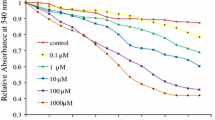Abstract
Previous studies from this laboratory have shown a concentration-time dependent, site specific cytotoxicity of CCl4 in slices. The present study examined radical formation and lipid peroxidation as a potential mechanism of toxicity. Liver slices from male Sprague-Dawley rats (220– 250 g) were exposed to 0.57 mM CCl4 by vaporization using a roller incubation system. Cytochrome P-450 is responsible for the bioactivation of CCl4 generating the CCl3 radical, which also acts as a suicide inhibitor. In slices exposed to CCl4, cytochrome P-450 loss occurred in a timedependent manner relative to controls (↓ 58% at 9 hr). A 48 hr fast prior to sacrifice both enhanced and accelerated both cytochrome P-450 loss as well as CCl4 toxicity in slices. Unlike cytochrome P-450, glutathione levels were not altered over the course of the experiment. These studies suggest that centrilobular hepatocytes are more susceptible to CCl4 induced injury. Covalent binding studies using 14CC14 confirmed CCl3 radical formation by cytochrome P-450. Binding to slice proteins plateaued as early as 30 min following CCl4 administration whereas lipid binding was saturated by 60 min. Covalent binding of the CCl3 radical was increased two-fold 60 min following phenobarbital pretreatment whereas allylisopropylacetamide caused the converse (50% at 60 min). Conjugated diene formation, an index of lipid peroxidation as detected by 15 min following
Access this chapter
Tax calculation will be finalised at checkout
Purchases are for personal use only
Preview
Unable to display preview. Download preview PDF.
Similar content being viewed by others
References
Azri, S., Gandolfi, A.J., and Brendel, K. (1989). Carbon tetrachloride toxicity in precision-out rat liver slices. In Vitro Toxicol. in press.
Chen, P.S., Toribara, T.Y., and Warner, H. (1956). Microdetermination of phosphorus. Anal. Chem. 28, 1756–1758.
Direnzo, A.B., Gandolfi, A.J., Brooks, S.D., and Brendel K. (1985). Toxicity and biotransformation of volatile halogenated anesthetics in rat hepatocytes. Drug Chem. Toxicol. 8, 207–218.
Estabrook, R.W., Peterson, J., Baron, J., and Hildebrant, A. (1972). The spectrophotometric measurement of turbid suspensions associated with drug metabolism. Methods Pharmacol. 2, 303–350.
Gandolfi, A.J., White, R.D., Sipes, I.G., and Pohl, L.R. (1980). Bioactivation and binding of halothane in vitro: Studies with 3H and 14C halothane. J. Pharm. Exp. Ther. 214, 721–725.
Glende, E.A. (1972). Carbon tetrachloride-induced protection against carbon tetrachloride toxicity. The role of the liver microsomal drug-metabolizing system. Biochem. Pharmacol. 21, 1697–1702.
Hong, J., Pan, J., Gonzales, F.J., Gelboin, H.V., and Yang, C.S. (1987). The induction of a specific form of cytochrome P-450 (P450j) by fasting. Biochem. Biophys. Res. Commun. 142, 1077–1083.
Johansson, I., Ekstrom, G., Scholte, B., Puzycki, D.,Jornvall, H., and Ingelman-Sundberg, M. (1988). Ethanol-, fasting-and acetone-inducible cytochrome P-450 in rat liver: regulation and characteristics of enzymes belonging to the IlB and IIE gene subfamilies. Biochemistry 27, 1925–1934.
Jungermann, K., and Katz, N. (1989). Functional specialization of different hepatocyte populations. Physiol. Rev. 69, 708–764.
Recknagel, R.O., and Glende, E.A. (1973). Carbon tetrachloride hepatotoxicity: An example of lethal cleavage. CRC Crit. Rev. Toxicol. 27, 263–295.
Sell, D.A., and Reynolds, E.S. (1969). Liver parenchymal cell injury. VII lesions of membranous cellular components following iodoform. J. Cell. Biol. 41, 736–752.
Author information
Authors and Affiliations
Editor information
Editors and Affiliations
Rights and permissions
Copyright information
© 1991 Plenum Press, New York
About this chapter
Cite this chapter
Azri, S., Mata, H.P., Gandolfi, A.J., Brendel, K. (1991). CCl4-Induced Cytochrome P-450 Loss and Lipid Peroxidation in Rat Liver Slices. In: Witmer, C.M., Snyder, R.R., Jollow, D.J., Kalf, G.F., Kocsis, J.J., Sipes, I.G. (eds) Biological Reactive Intermediates IV. Advances in Experimental Medicine and Biology, vol 283. Springer, Boston, MA. https://doi.org/10.1007/978-1-4684-5877-0_84
Download citation
DOI: https://doi.org/10.1007/978-1-4684-5877-0_84
Publisher Name: Springer, Boston, MA
Print ISBN: 978-1-4684-5879-4
Online ISBN: 978-1-4684-5877-0
eBook Packages: Springer Book Archive




